Once the imperial seat of Charlemagne’s empire, Aachen is now a popular spa city in western Germany. Find out what there is to do in Aachen, Germany in this post!
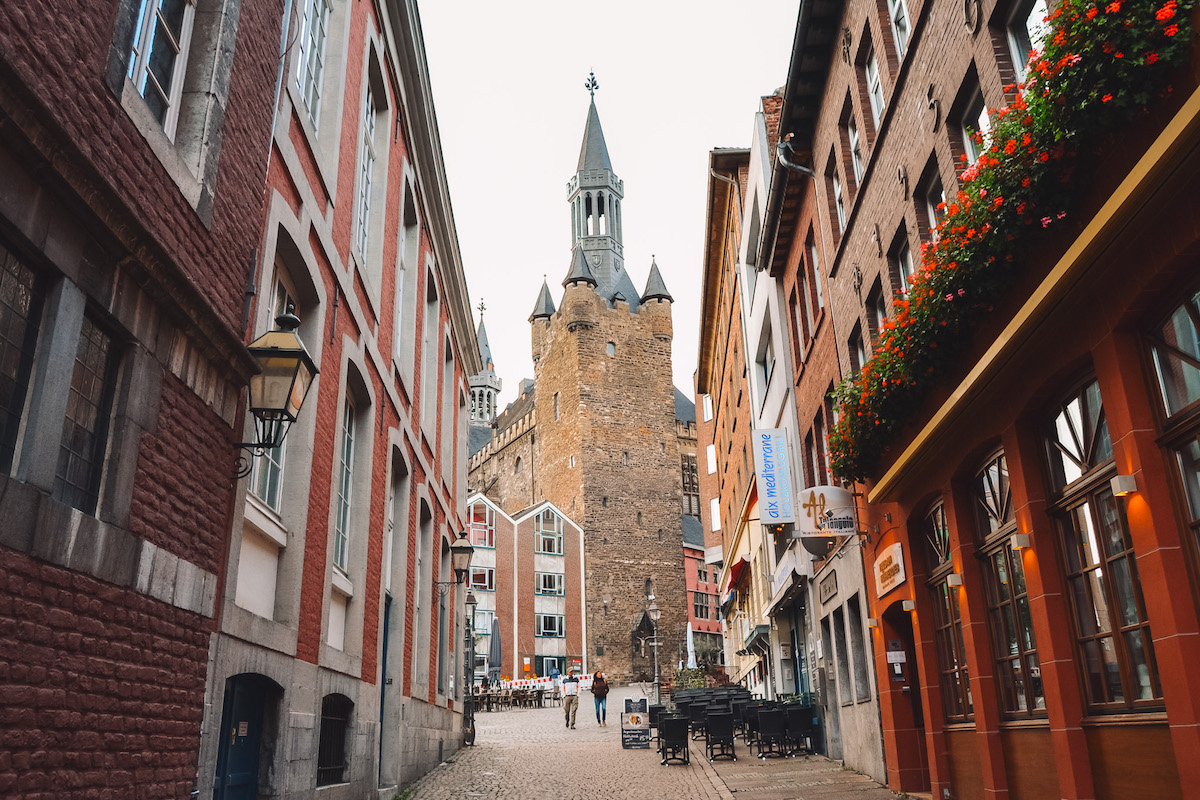
If you take the train to the westernmost point of Germany, you’ll come to the lovely little city of Aachen. Bordering Belgium and the Netherlands, Aachen is a multicultural city with roots dating back to the Neolithic Age. Historically, it’s one of the most important political and cultural cities in all of Germany. Aachen served as Charlemagne’s imperial city, and his legacy influences the region to this very day.
In addition to its ties with Charlemagne, Aachen is known for being a spa city. Multiple thermal springs in the area provide healing waters to the spas in the area. Aachen is also known for having one of the finest Christmas markets in Germany.
For such a small city, Aachen is a melting pot of history and cultures thanks to its unique location on the German border. If you’re wondering whether Aachen is worth visiting, it most certainly is! This post will share what to do in Aachen, Germany and will also answer some FAQs about visiting Germany’s westernmost city.
Table of Contents
Click “show” to see the full table of contents for this post. You can jump around the post as desired by clicking on the individual sections listed below.
Follow the Route Charlemagne
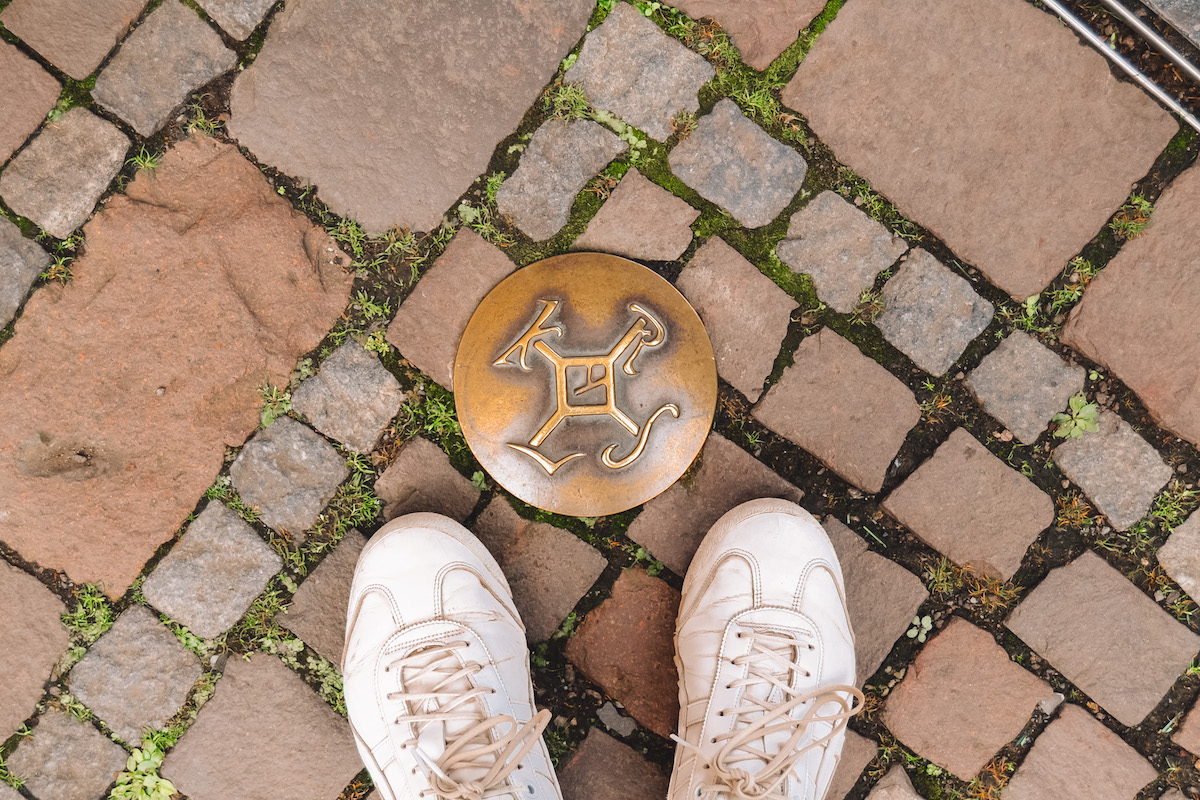
Charlemagne’s lasting impact on the city of Aachen, Germany cannot be understated. He’s mentioned in practically every museum in the city, and if you know what to look for you can see his footprint on the architecture of the city as well.
In addition to being King of the Franks and Lombards, Charlemagne was also the Holy Roman Emperor. Despite having palaces throughout his empire, Charlemagne favored Aachen above all others. Aachen served as Charlemagne’s imperial city, and he built it up around 800 AD.
History lovers interested in learning more about the life and legacy of Charlemagne should follow the Route Charlemagne through Aachen. This route takes you through the city to visit the sites influenced by or dedicated to Charlemagne, making it one of the can’t-miss things to do in Aachen.
Some — but not all — of Aachen’s tourist attractions shared in this post fall along the route, so I wanted to highlight it especially in case you’re visiting the city specifically to learn more about the city’s most famous ruler.
Visit the Aachen Cathedral and Treasury
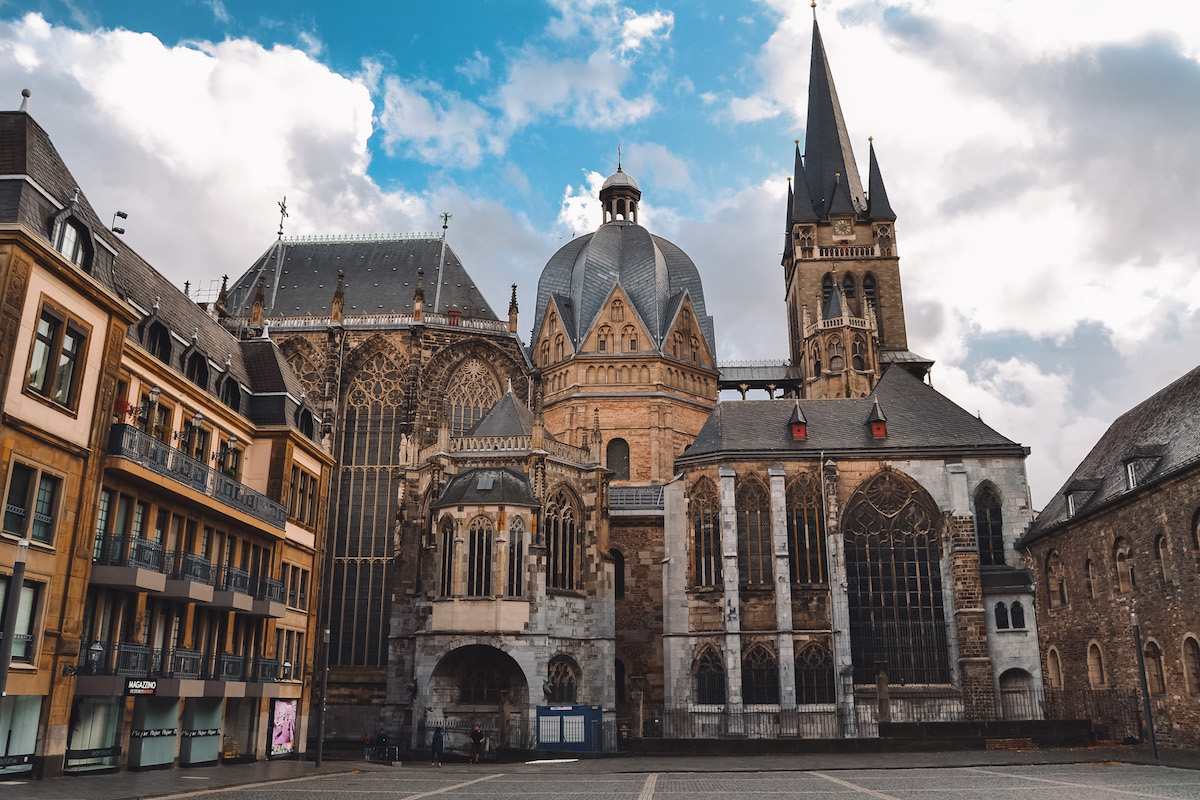
The Cathedral the place to see in Aachen, Germany. Originally called the Royal Church of St. Mary, the Aachen Cathedral (Aachener Dom) was built by — you guessed it! — Charlemagne, and his final resting place can be found here.
Following Charlemagne’s death, the Cathedral served as the coronation site for Roman German kings and queens. 30 German kings and 12 queens were anointed here!
The Aachen Cathedral was also one of the most important pilgrimage sites in Europe during the Middle Ages. The Aachen Pilgrimage takes place every seven years to this very day, with the last pilgrimage supposed to have taken place in 2021. During the time of the Aachen Pilgrimage, the four relics contained in the Shrine of Saint Mary are put on display for pilgrims to see. When it’s not a pilgrimage year, the relics are hidden within the shrine.
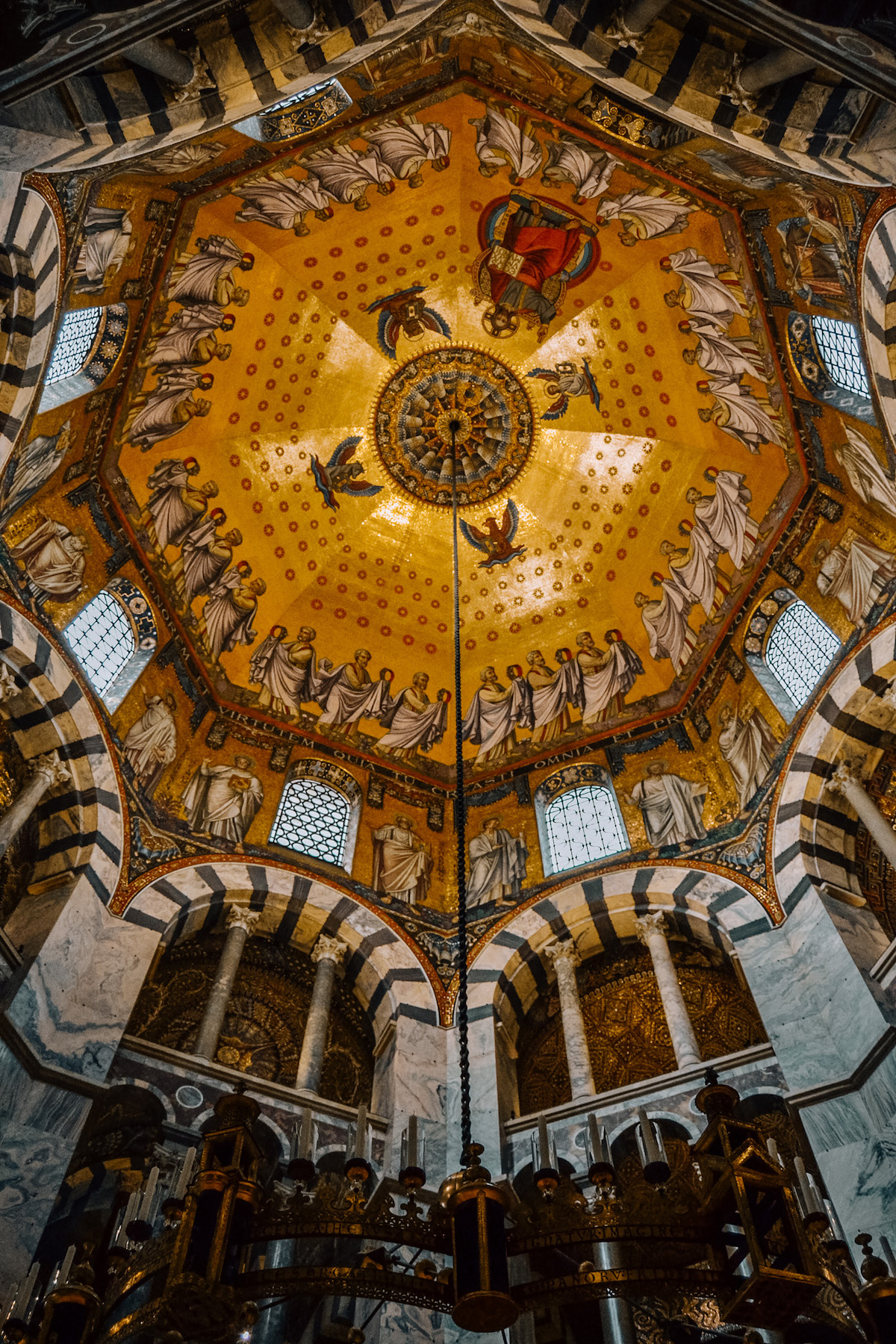
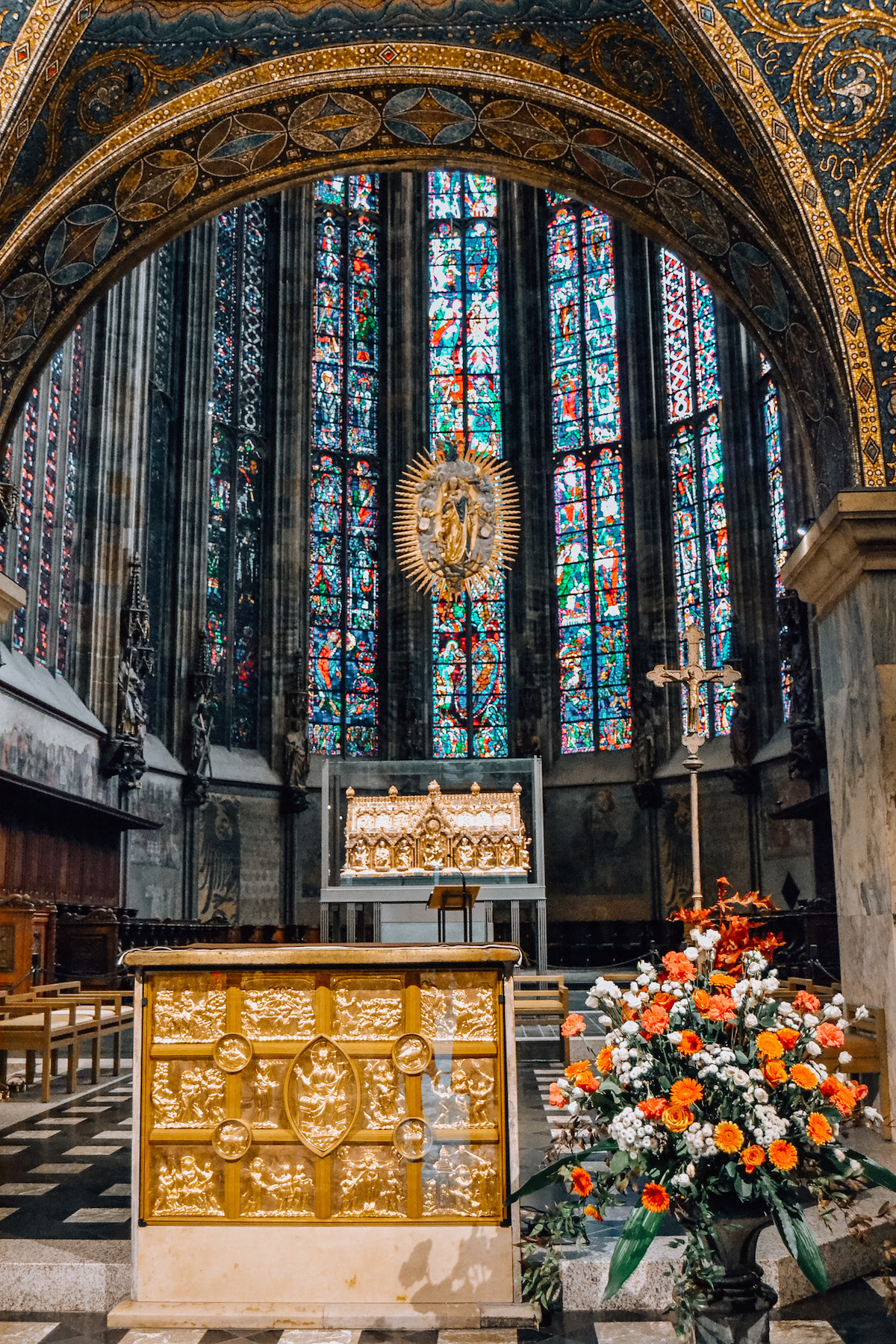
In addition to the Shrine of Saint Mary, visitors to this stunning octagonal cathedral will see the Shrine of Charlemagne (where his remains rest) and the golden altar that dates back to 1020 AD.
After admiring the cathedral, be sure to visit the cathedral treasury, which is just around the corner. You’ll have to pay to enter, but it’s worth every Euro! The treasury displays over 100 pieces of religious art, all having something to do with the history of the Aachen Cathedral.
Relax at a Thermal Spa
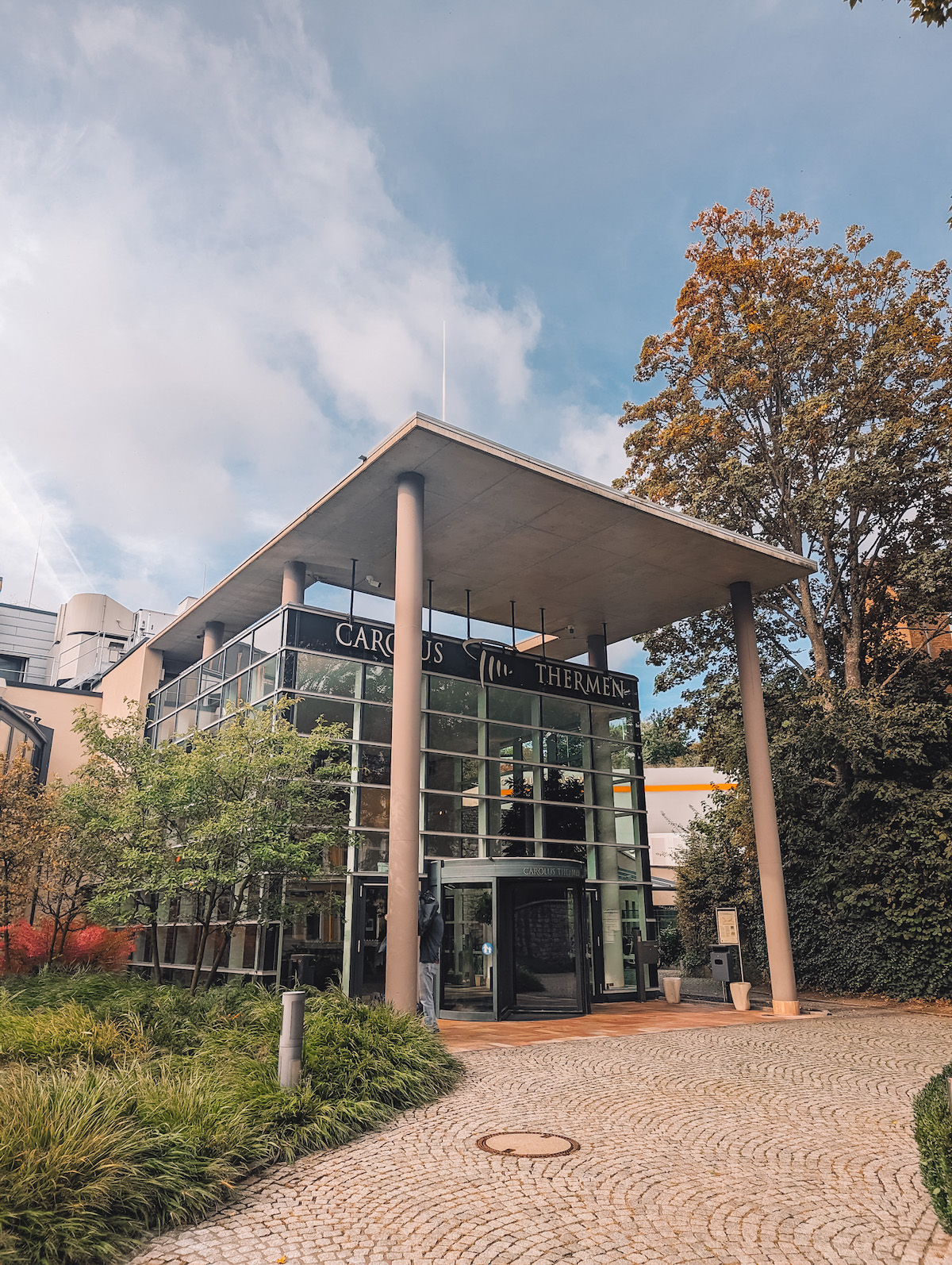
One of the top attractions in Aachen is its soothing thermal springs. Thanks to the roughly 30 natural thermal springs in and around Aachen, it has a reputation for being one of the best spa cities in Germany.
In fact, Aachen’s thermal springs have been a popular tourist attraction since Roman times! Charlemagne in particular prized Aachen’s thermal waters (which were believed to have healing properties). Throughout the centuries, many other famous figures have come to Aachen to bathe in the hot springs, including Frederick the Great and Napoleon Bonaperte.
The best-known thermal spa in Aachen is Carolus Thermen. It took me a few visits to Aachen before I finally visited the thermal springs, and I’m kicking myself for not going sooner!

A spring in the city center supplies Carolus Thermen with its mineral-rich bathing waters. The interior of the spa looks like a luxury swimming complex, with indoor and outdoor pools of varying temperatures for visitors to relax in.
The day pass for the thermal baths costs just 20 Euros, and if you also want access to the saunas it costs 42 Euros. Bring your swimsuit, a good book, and prepare to relax!
Tour the Town Hall
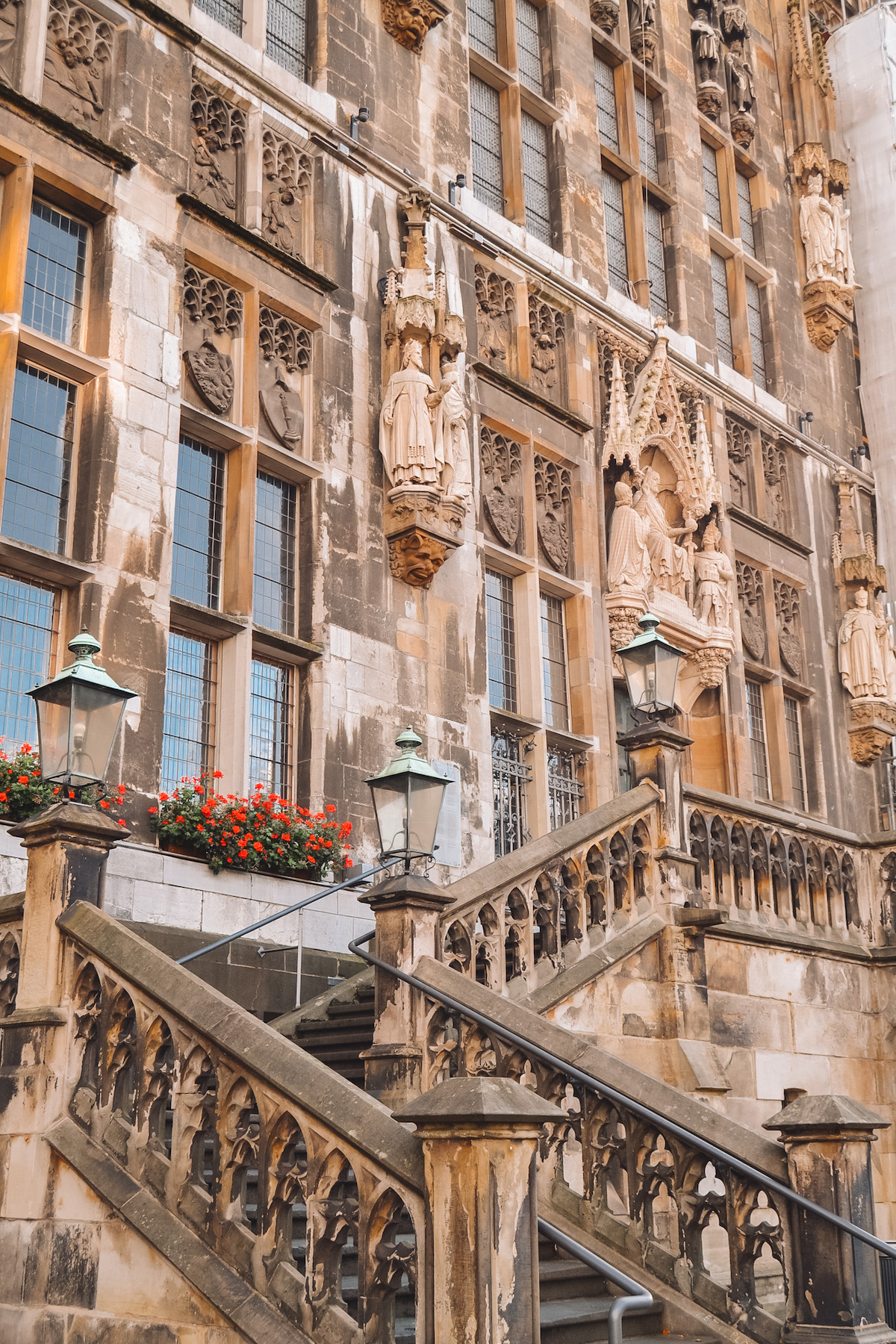
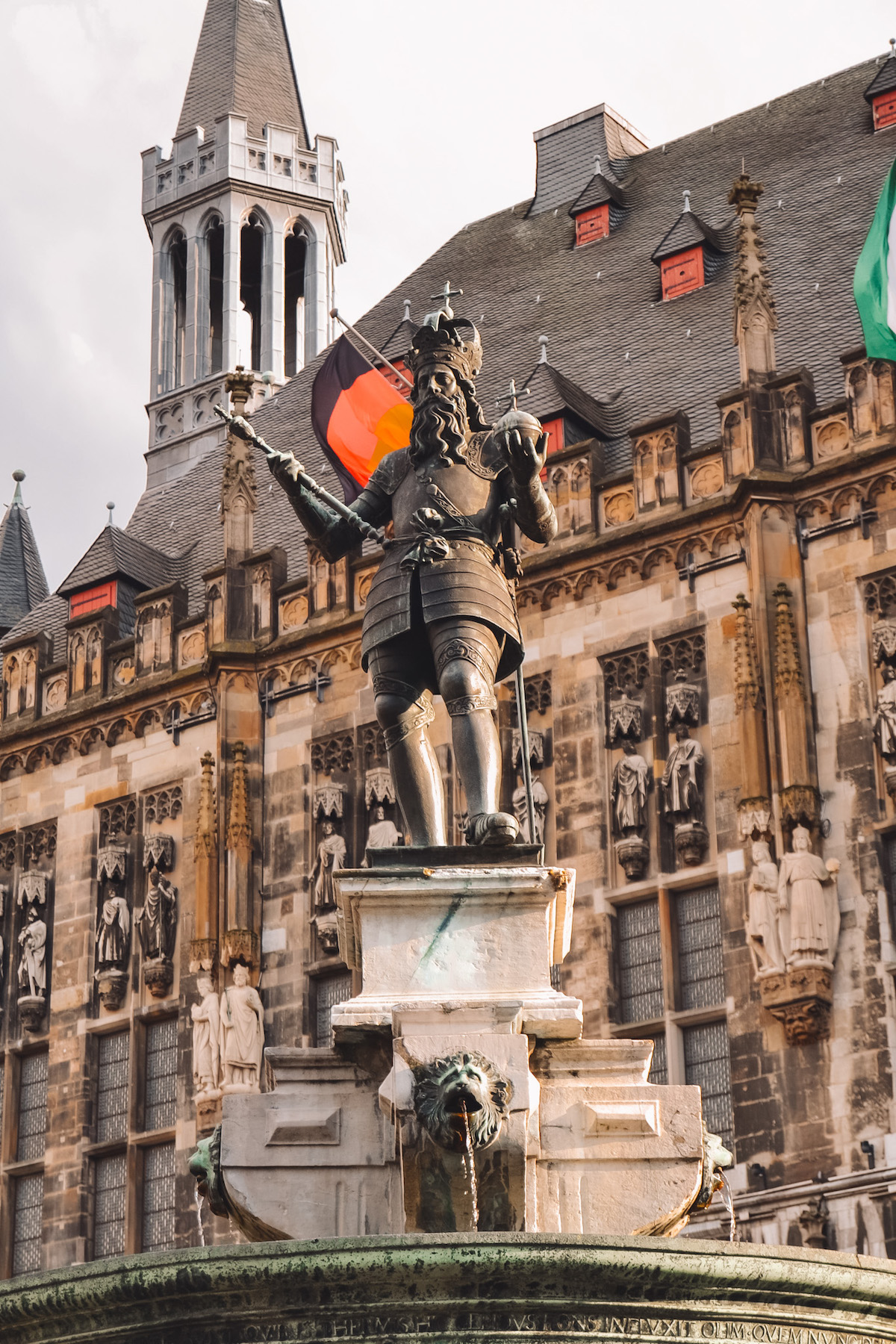
Charlemagne’s legacy doesn’t end with the Cathedral! Oh no, the Town Hall was also built on the former site of Charlemagne’s palace. Since the initial Gothic-style Town Hall was completed in 1350, the building has been subsequently damaged and rebuilt many times.
Following fires in the 1650s and 1880s, the Town Hall was restructured and rebuilt. Then, after being damaged by bombing raids during WWII the Town Hall was once again rebuilt — that’s the structure you’ll see during your visit to Aachen today.
Although the building itself has evolved over the centuries, the purpose of the Town Hall has remained the same. It’s both the seat of the local government and also serves as a hall for state celebrations and banquets.
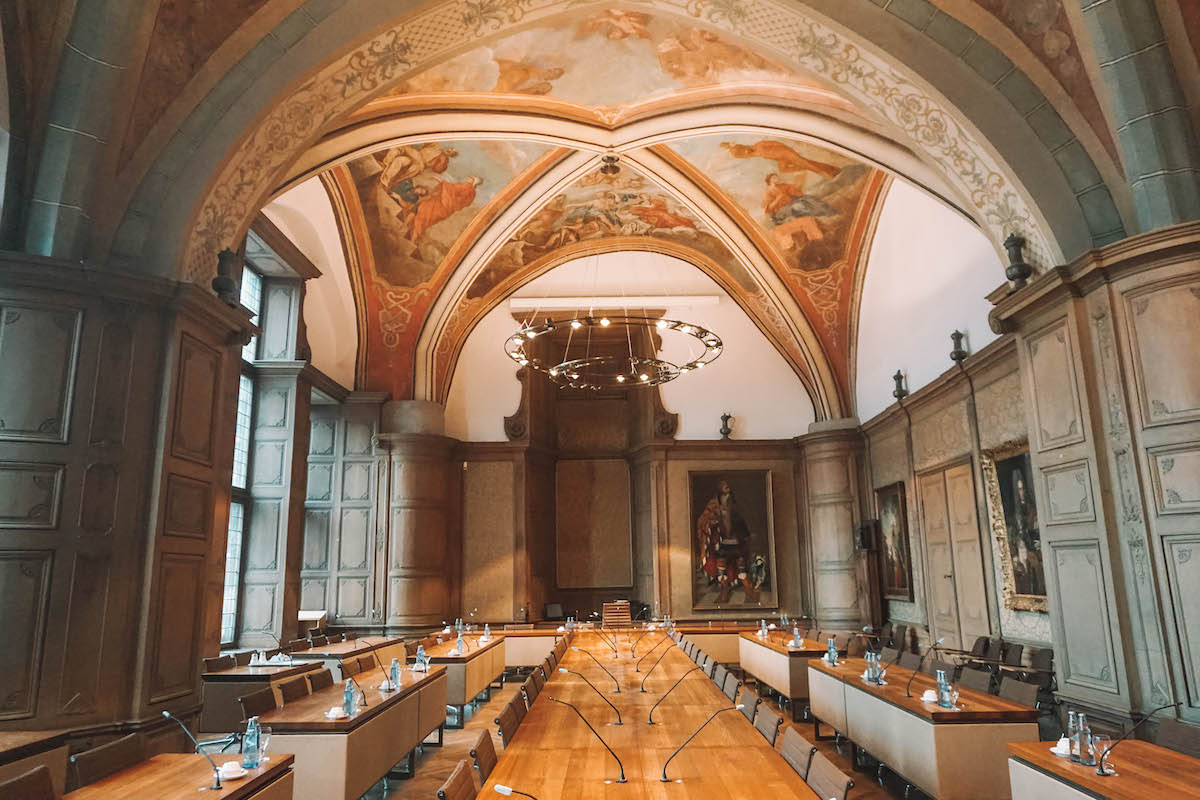
I enjoyed my self-guided tour of the Town Hall, and it’s one of my favorite tourist attractions in Aachen, Germany. I only needed about an hour to go through it, and I enjoyed the interactive touchscreen displays scattered throughout the building.
Highlights of the Town Hall include: The Council Hall, where the local government still adjourns, and The Red Hall, where the “Aachen Peace” was supposed to be negotiated in 1748 to end the Austrian War of Succession (weirdly enough, the room is still dedicated to the “Aachen Peace” despite the peace agreement actually having taken place elsewhere in the Town Hall).
Tip: Be sure to look out the windows while going up the stairs inside the Town Hall. The view of the Cathedral from the second floor is incredible!
Visit a Museum
Aachen has a great “6 for 6” museum ticket. You pay just $14 for admission to the city’s top six museums, and the ticket is valid for six months.
The museums included with the ticket are: Ludwig Forum, Suermondt-Ludwig-Museum, Couven Museum, Charlemagne Center, International Newspaper Museum, and the Town Hall.
Coven Museum
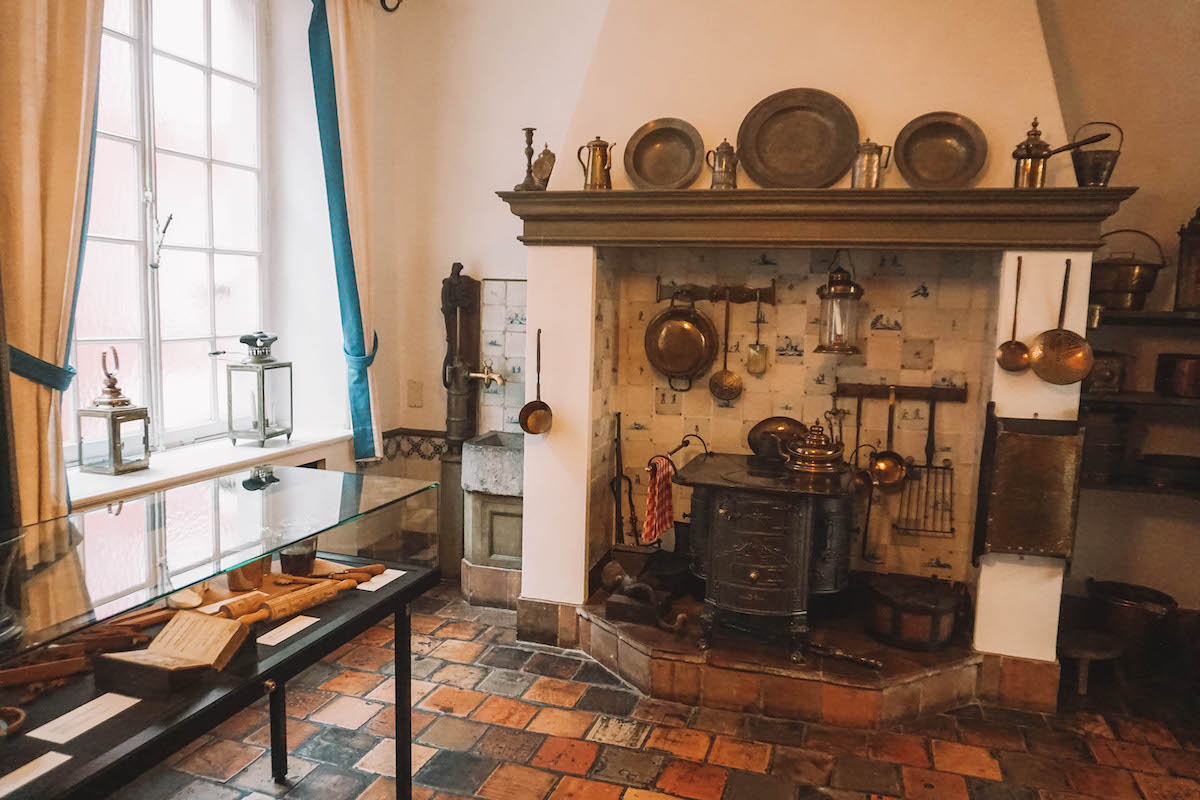
The Couven Museum is a small but interesting museum in the Old Town that illustrates how Aachen’s upper-middle class lived during the 17th through 19th centuries. Each room is decorated with furniture from various periods in Aachen’s history. The museum was quirky, but I enjoyed the unique combination of history and interior design lessons in each room.
The building itself is also quite impressive. The Couven Museum is located in an 18th century townhouse that was built in the Rococo style. I’m a sucker for a good house museum, so the Couven Museum was a highlight of my trip to Aachen!
Tip: You only need an hour to 90 minutes to visit this small museum.
Charlemagne Center
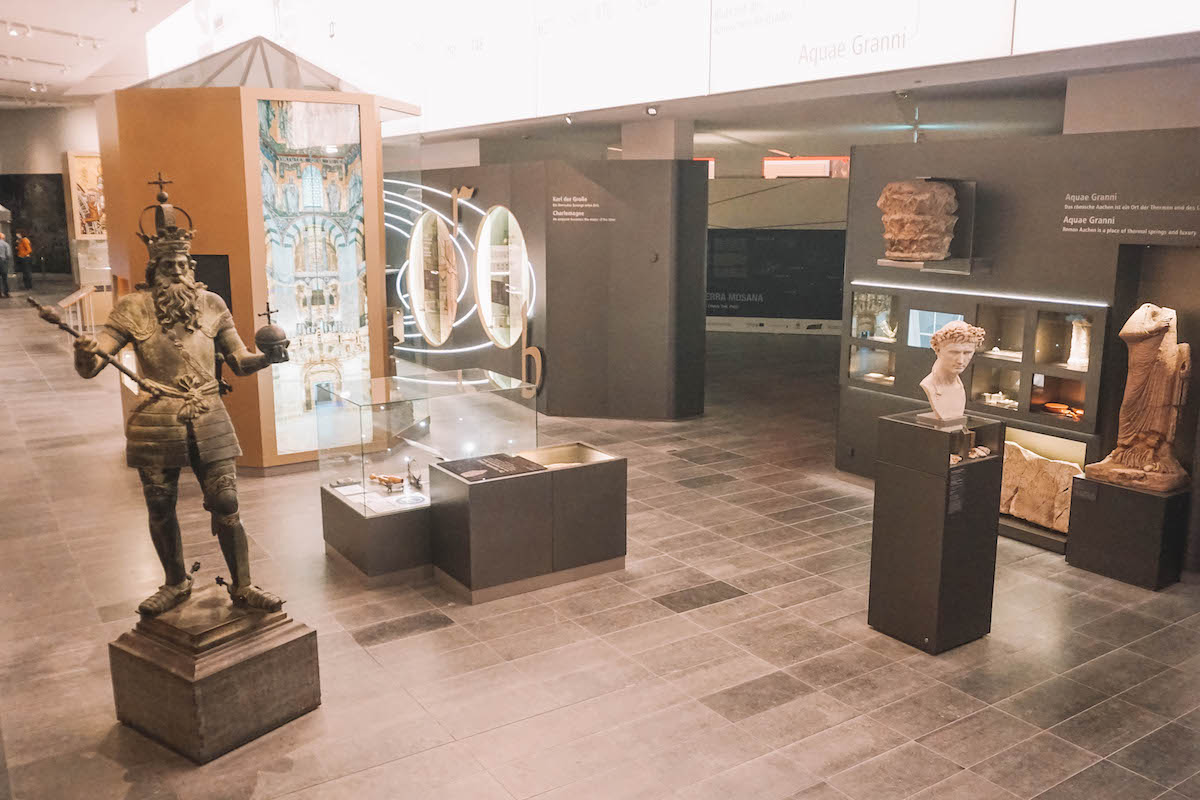
Located between the Cathedral and the Town Hall, the Charlemagne Center is one of the focal points of Aachen. Like most of the museums in Aachen, the Charlemagne Center is small but packed with information.
It walks you through the city’s history from the Neolithic period to present day, but with a focus on Charlemagne and his lasting impact on Aachen.
The Charlemagne Center consists mostly of interactive exhibits, with some key artifacts on display here and there. If you’re wondering what to do in Aachen and you love history, definitely visit the Charlemagne Center!
Tip: Much of the text is in German so be sure to ask the front desk for an audio guide in your native language if needed.
Suermondt-Ludwig-Museum
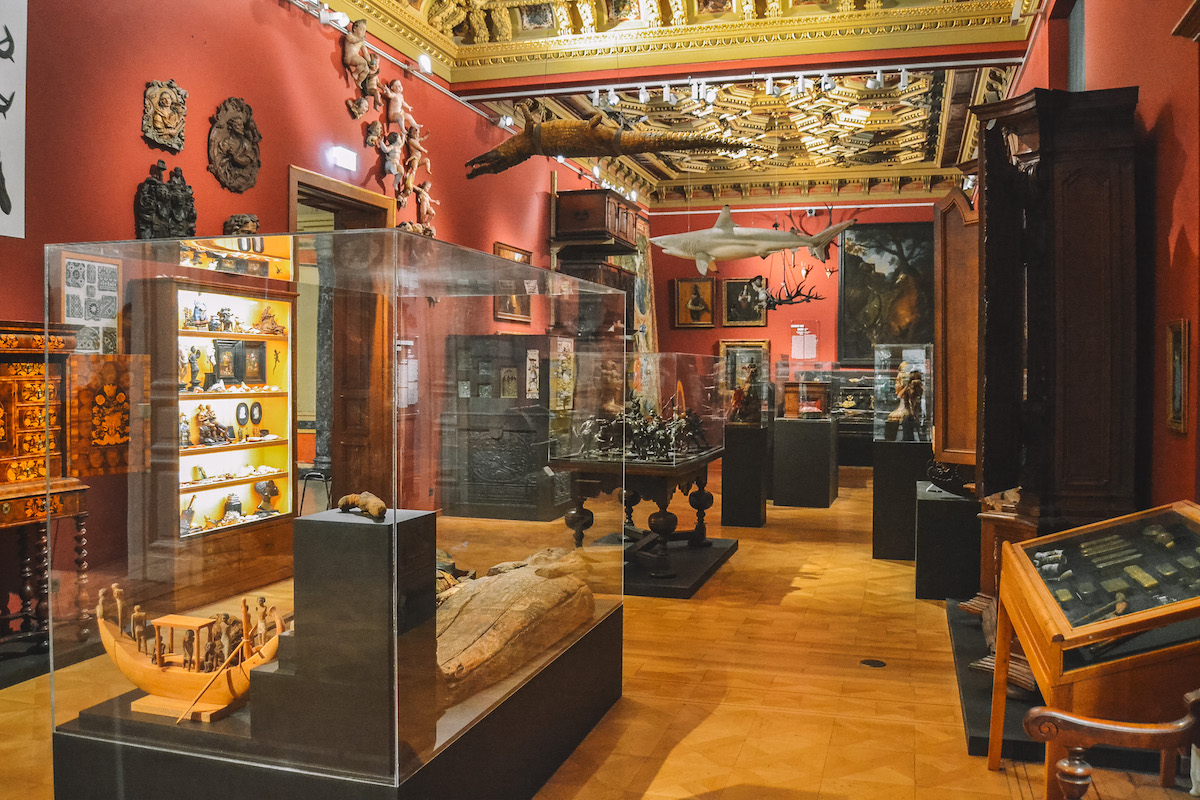
The Suermondt-Ludwig-Museum is a lovely art museum housed in the former Villa Cassalette. The museum showcases artwork from the antiquity to classic modern periods, including a variety of sculptures, painted glass, paintings, and more.
The gorgeous neo-Baroque staircase was one highlight of my visit, as was the Civic Cabinet of Arts and Curios” which is arranged like a 19th century curiosity cabinet. There was an intriguing variety of artifacts from various time periods, all thrown together next to each other. I saw an Egyptian mummy, Greek vases, a stuffed crocodile, and other oddities sitting side by side.
Tip: The Suermondt-Ludwig-Museum is one of Germany’s largest municipal museums, sp give yourself 2 to 3 hours to visit.
Explore the Old Town
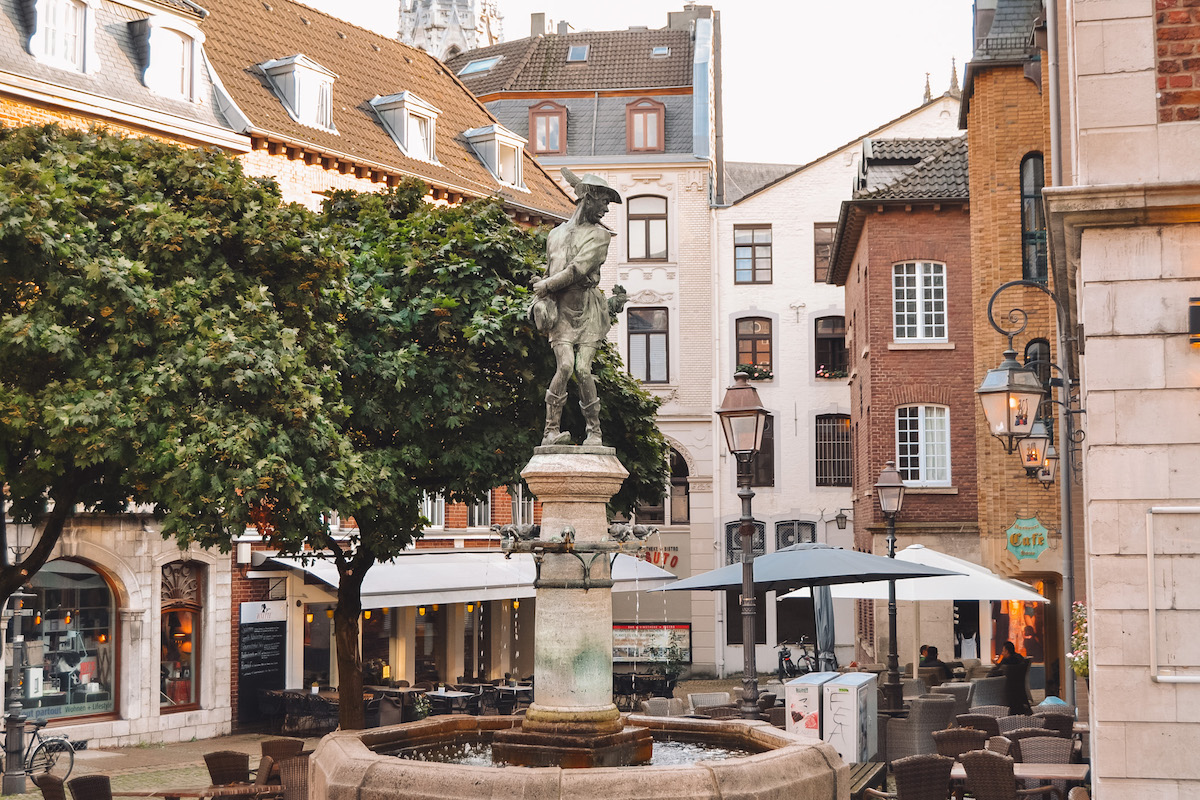
Aachen has one of the most beautiful Old Towns I’ve seen in Germany! Traces of its medieval roots can still be seen in the architecture, and looking at it today you’d never know that much of the city was damaged during WWII.
Aachen’s Old Town is filled with shops, bakeries, and cafes. Seemingly every other storefront is a quaint bakery selling Printen cookies (more on that in a bit!), so definitely come hungry!
Many of the top things to do in Aachen are located within the Old Town, so you can expect to spend most of your visit here. It’s a small area, but you can easily spend a full day here running around to the different sights!
Admire the Old City Gates
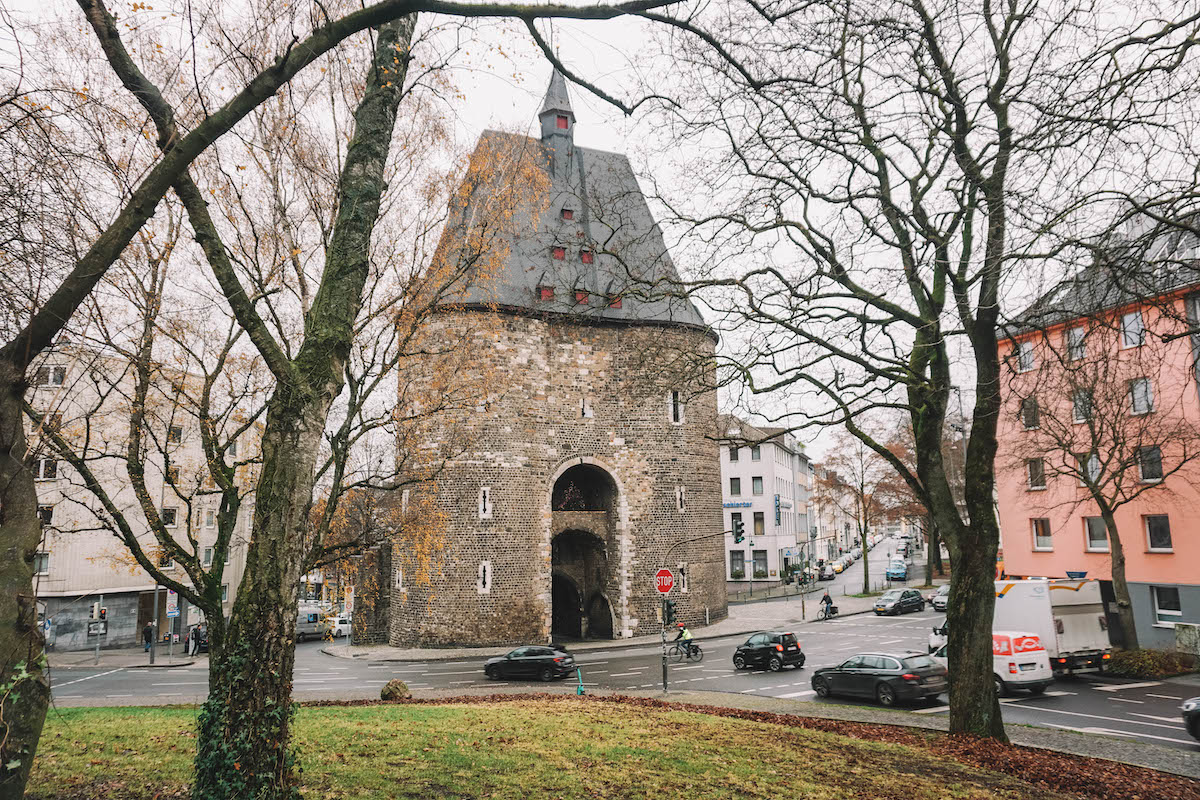
Only two of Aachen’s 11 medieval city gates remain, the Marschiertor (pictured above) and the Ponttor.
These gates are MASSIVE, and while they’re not necessarily a “must see” Aachen attraction (I mean, they’re stone gates) they’re still fun to track down if you have extra time to do a little exploring beyond the boundaries of the Old Town.
Visit the Three Country Point
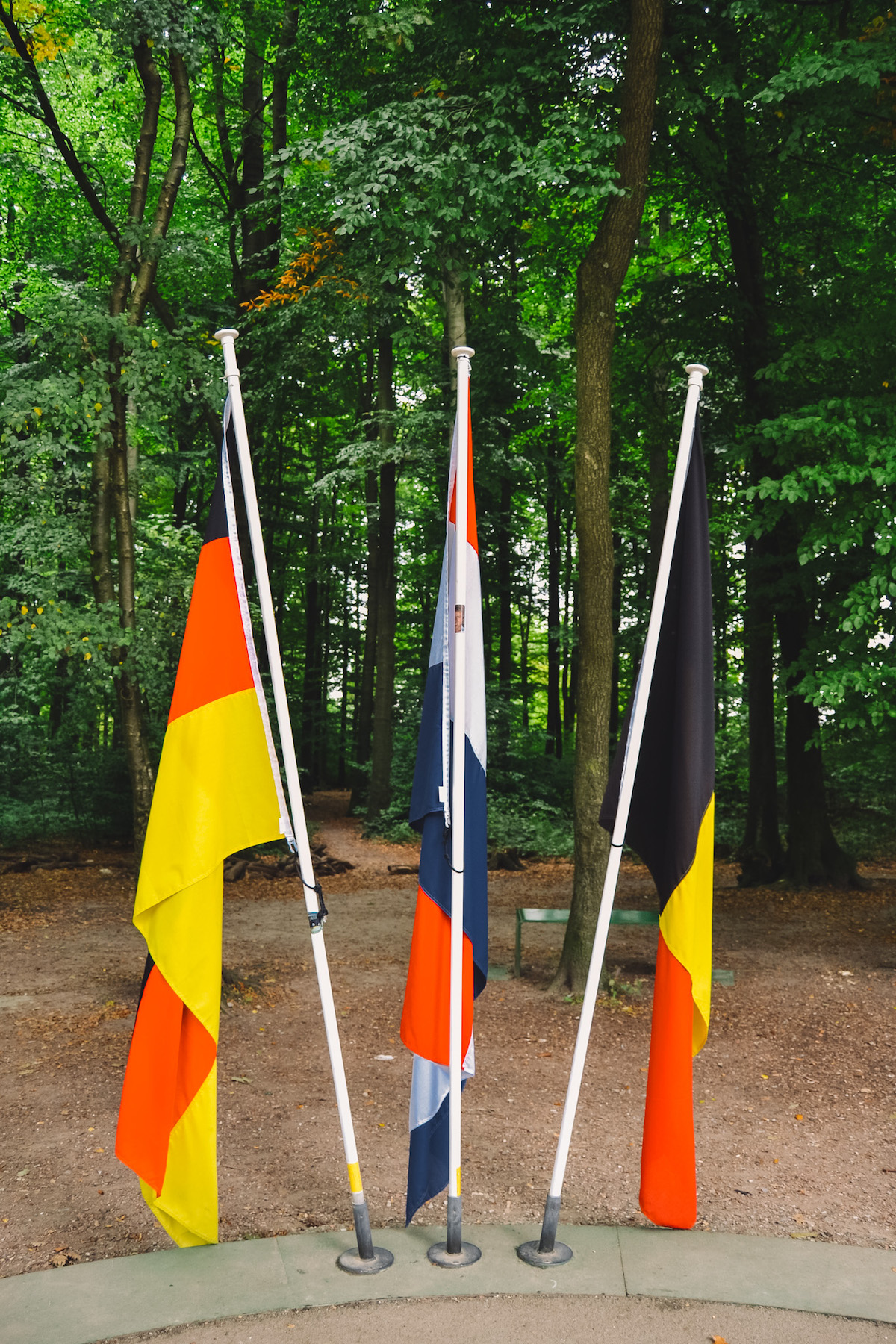
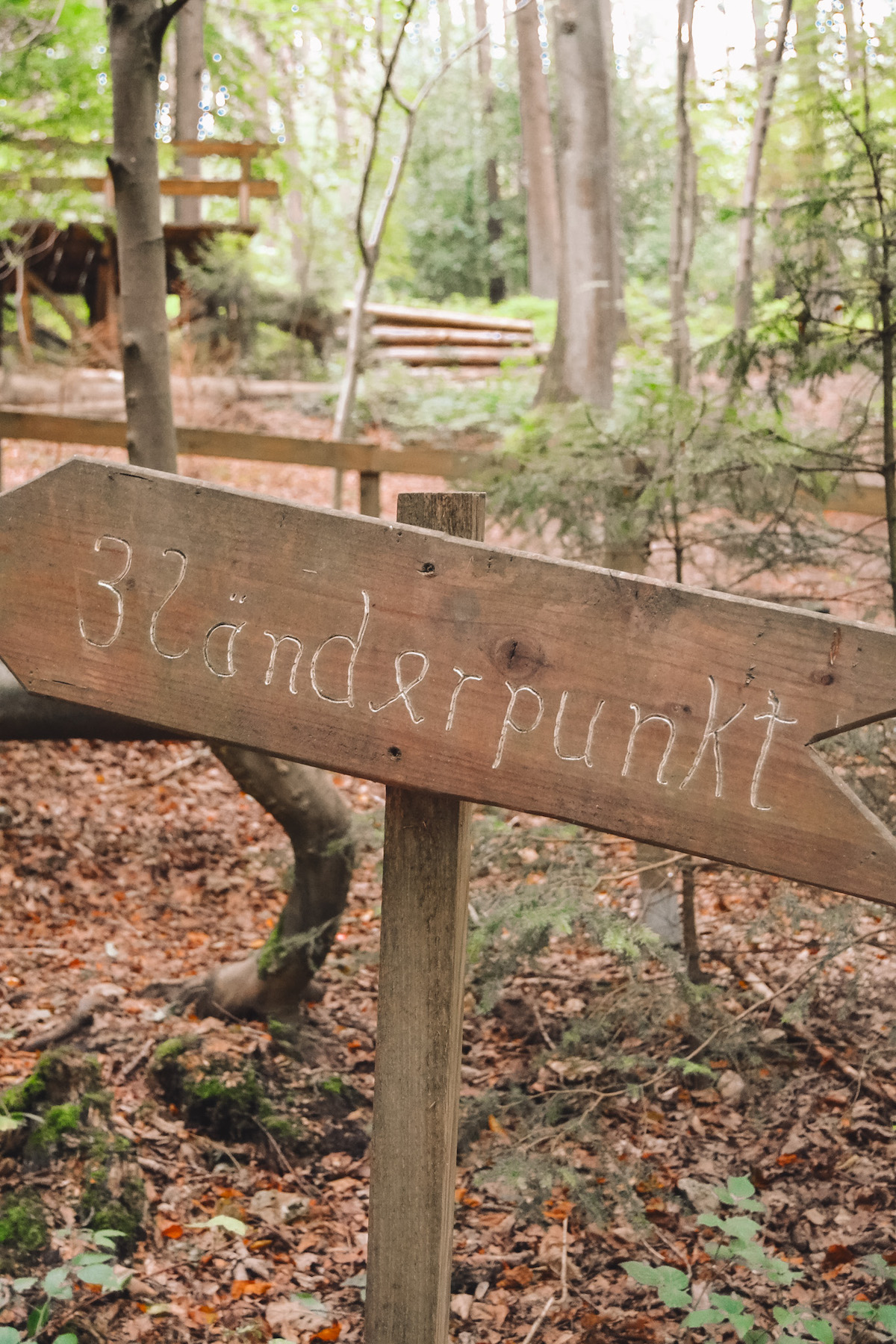
The Three Country Point (Dreiländerpunkt) lies just outside the city center and is where the Netherlands, Germany, and Belgium meet. There are three flags flying side by side, should you want to take a photo of yourself.
You’ll also find a labyrinth, a small cafe, and a restaurant at the Three Country Point. If you’ve been to the city a few times like I have and want to do something a little more unusual, the short trek out to the Three Country Point makes for a fun excursion. Definitely a more unusual Aachen sightseeing activity!
Tip: You can either drive roughly 20 minutes to the Three Country Point, or you can take a bus to the “Vaalserquartier Keltenstraße” stop (which is just across the border from the Netherlands!) and hike for another 35 minutes to reach the spot where the three countries meet. It’s not a difficult hike at all, but tennis shoes are recommended.
Eat Aachener Printen Cookies
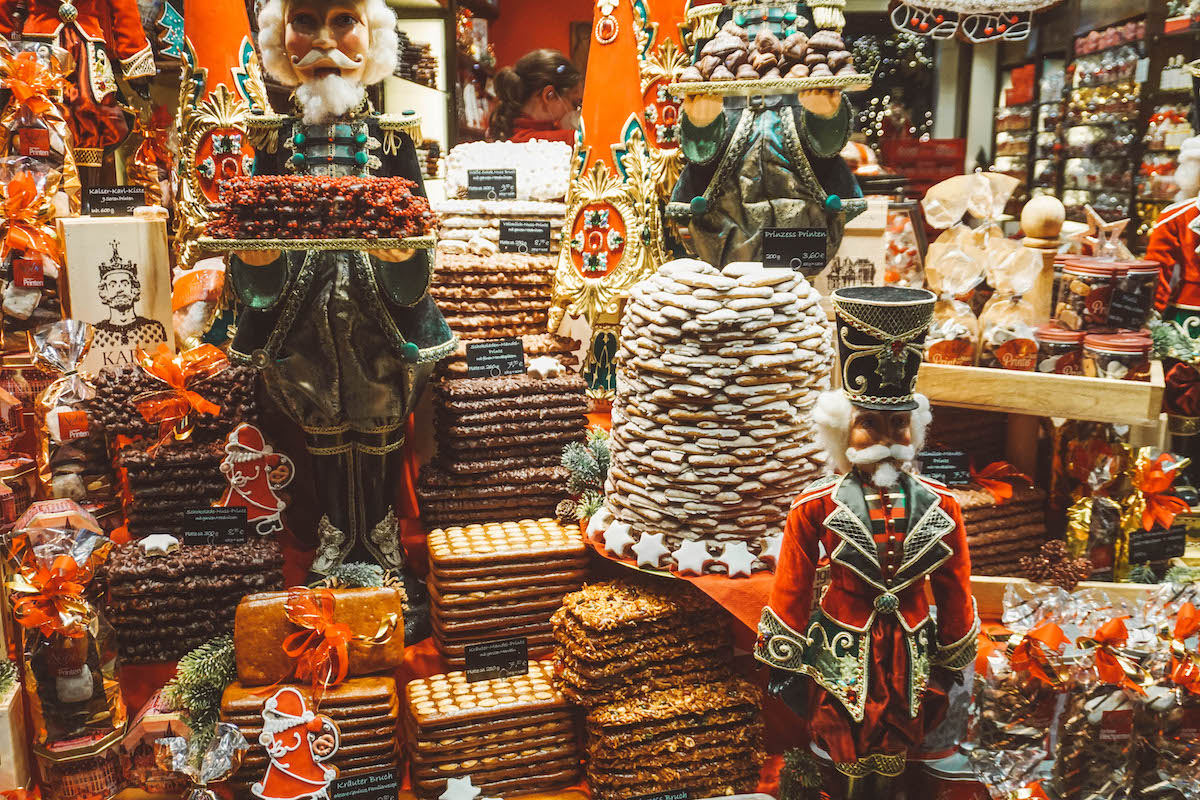
Aachener Printen are a regional specialty that you won’t find anywhere else in Germany. (Or rather, you’ll find cookies that are sold as “Printen” in other parts of the country but they’re not made in Aachen and therefore aren’t the real deal. Think of them as being the Champagne of German cookies!).
Aachener Printen are teeth-cracking, hard, spiced cookies. They’re similar in flavor to Lebkuchen (gingerbread) but the texture is totally different. As I mentioned above, the Old Town has lots of specialty Printen bakeries to choose from.
I got a bag of Printen from Nobis and thoroughly enjoyed them dunked in my morning cup of tea (I can’t eat them plain, they’re just too hard!).
Tip: Because Printen are already quite hard and are high in sugar, they make for wonderful gifts and travel well.
Feel the Thermal Waters at the Elisenbrunnen
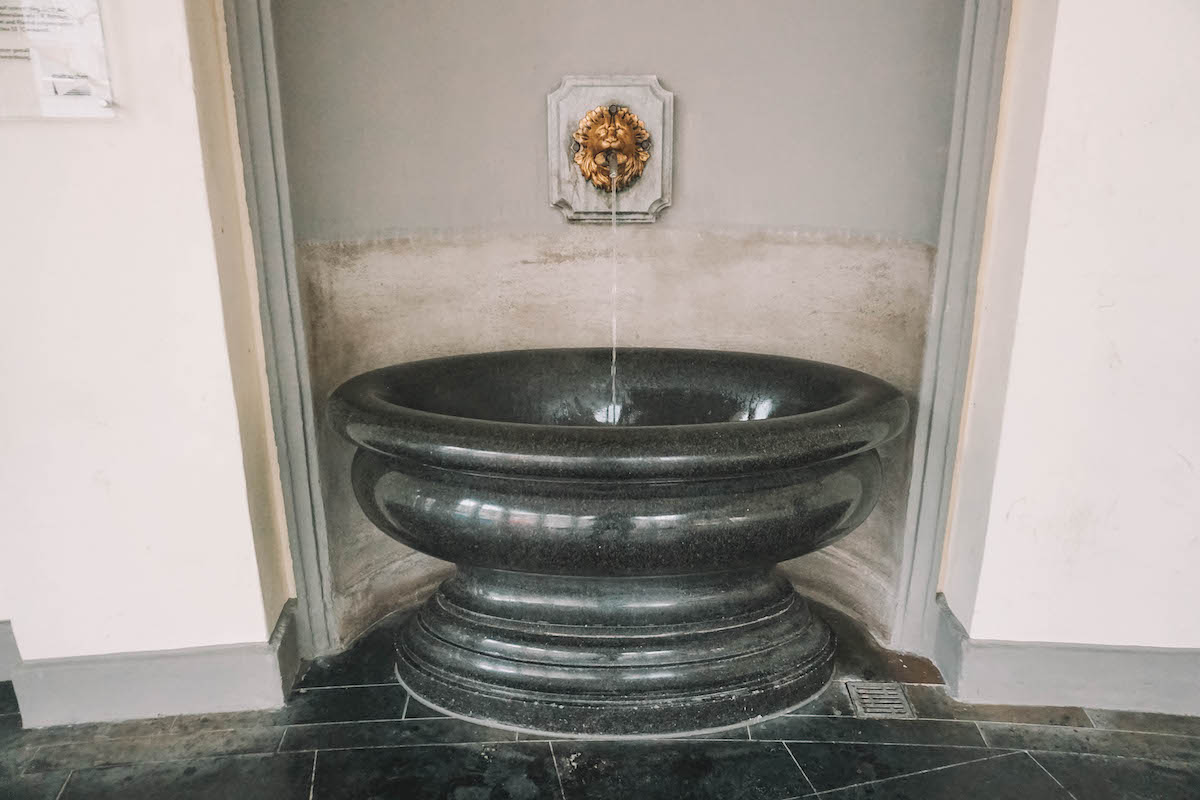
Besides Charlemagne’s legacy, Aachen is best known for being a spa city. Archeological evidence suggests that people first came to Aachen’s thermal springs as far back as the Neolithic Age!
The structure surrounding the Elisenbrunnen was completed in 1827, but the thermal spring itself has been there much longer than that. It draws thermal water from the same source that once filled Charlemagne’s palatine spa, although the spa is no longer standing.
There’s not much to see or do at the Elisenbrunnen, but it’s a key historic site in Aachen and is worth mentioning!
Tip: Make this your first stop in Aachen, as the tourist information center is housed in the same building as the Elisenbrunnen.
Visit the “Archaeological Window” in the Elisengarten
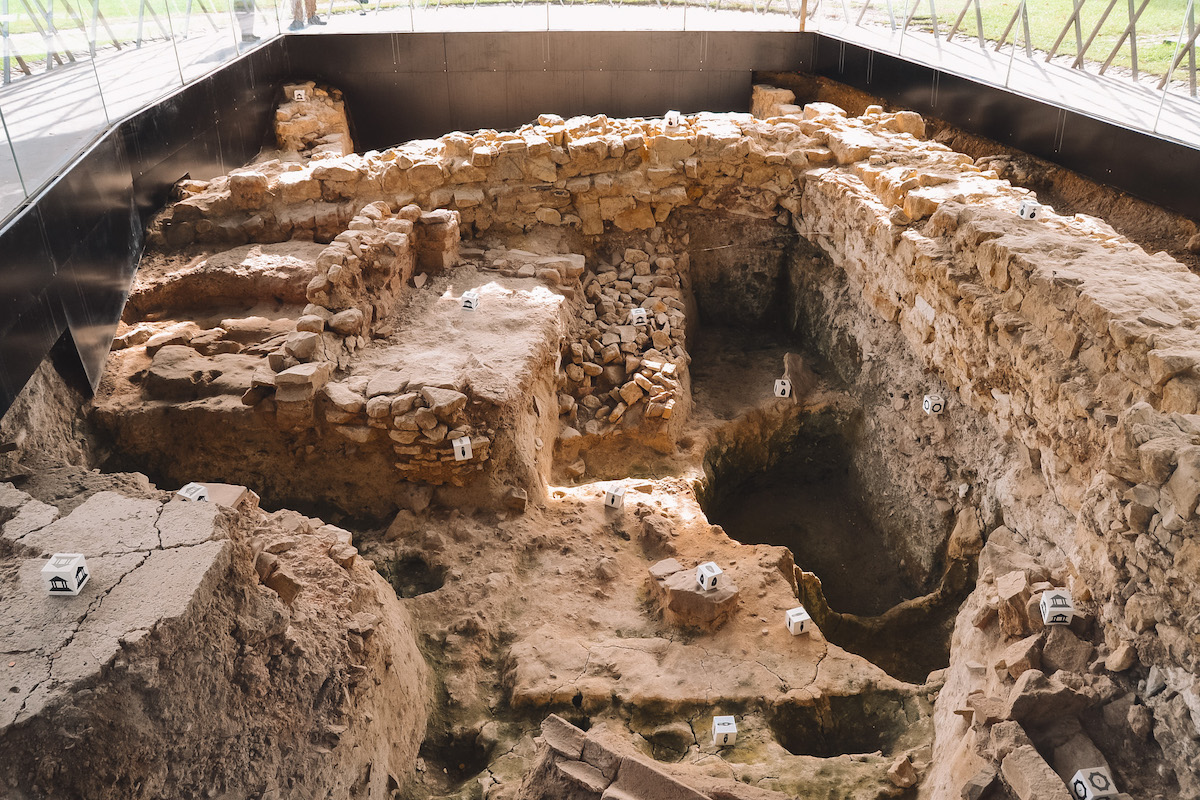
In the Elisengarten just behind the famous Elisenbrunnen (also mentioned in this guide), there’s a nondescript covered pavilion. Head inside to see one of the marvels of Aachen.
This pavilion is a so-called “Archaeological Window,” where you can look down into the ground and see what’s believed to be Roman and medieval foundations that were unearthed while excavating the park in the early 2000s. When the foundations were discovered, archaeologists erected a tent over the site and opened it to the public.
It was supposed to be temporary, but lucky for us the city commissioned a permanent structure to be built over the ruins so visitors from all over the world can get a glimpse into Aachen’s past. The Archaeological Window is free to enter, and you need just 15 to 20 minutes to read everything.
Bonus Activity: Visit the Christmas Market!
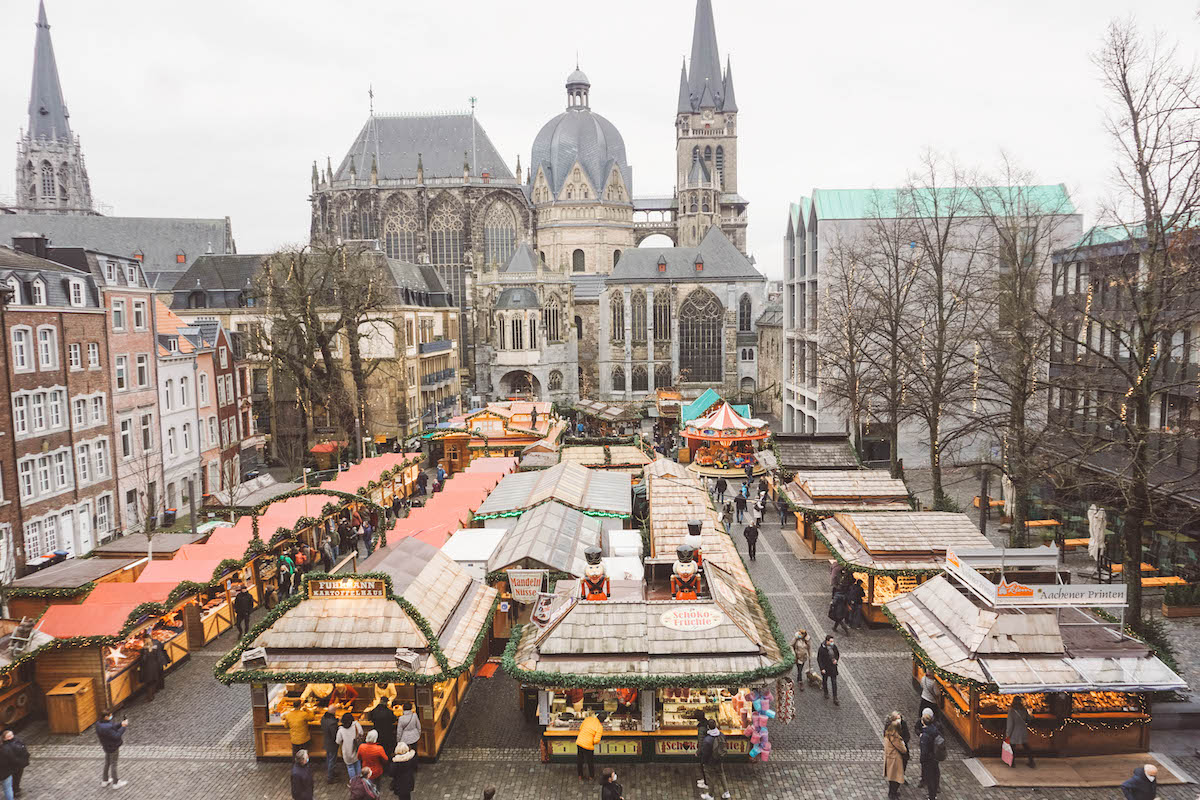
If you’re visiting Aachen during the holidays, consider yourself lucky! The Aachen Christmas market is one of my favorites in Germany. The market is quite large considering the city itself isn’t very big.
It stretches around the Cathedral and past the Town Hall, with lots of food options and stalls selling goods from Belgium, France, and Germany (very unusual for a German Christmas market!).
FAQs About Visiting Aachen, Germany

Where is Aachen, Germany?
Aachen is Germany’s westernmost city. It borders Belgium and the Netherlands.
How many days are needed to see Aachen?
I recommend spending 1 to 1.5 full days in Aachen if you’re just there to see the main attractions. However, if you plan on spending time relaxing at one of the city’s many spas, you’ll need more time to take in the sights.
Is a day trip to Aachen enough time?
If that’s all you’ve got, then yes! You won’t see all of the attractions in Aachen, but you’ll see a good chunk of it. Aachen would be a great day trip from Cologne in particular!
Where should I stay in Aachen?
I stayed at the ibis Aachen near the Marschiertor. It’s a budget-friendly hotel that looks to have been recently renovated and is within walking distance of the train station and Old Town.
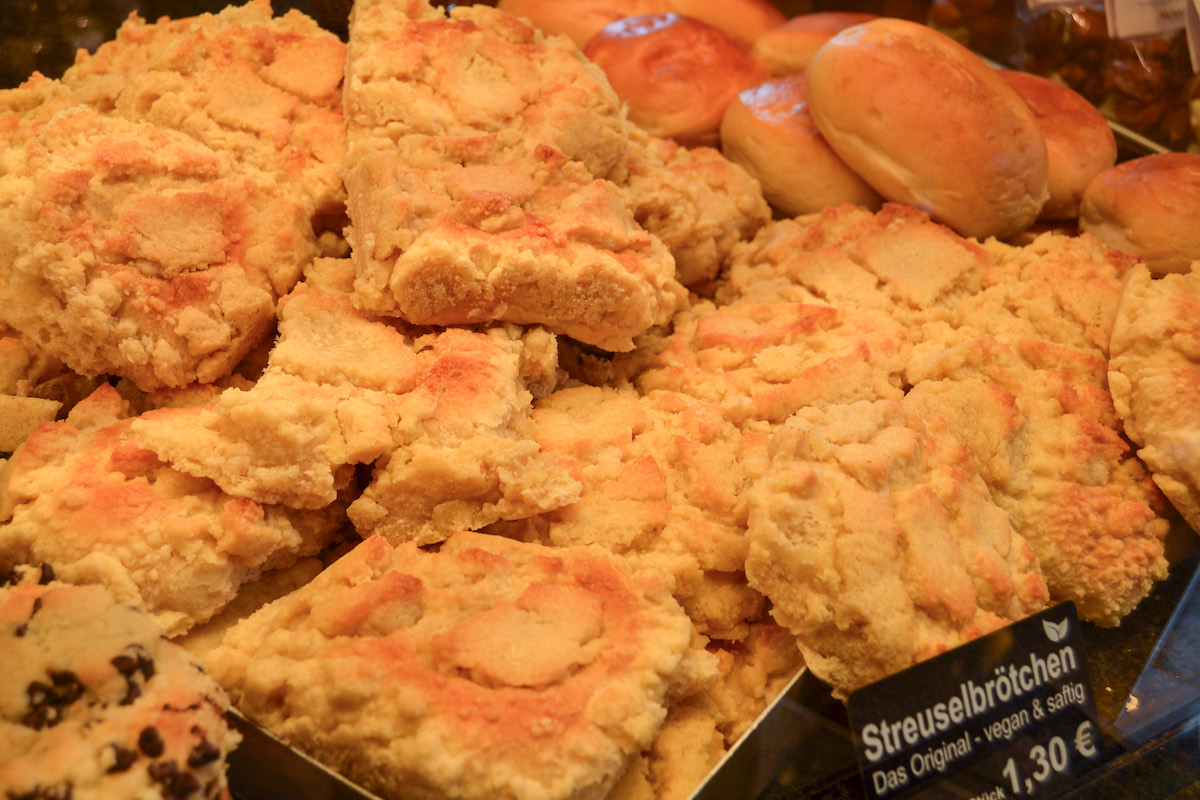
What foods should I eat in Aachen?
Definitely buy Printen cookies while in Aachen — you won’t find them anywhere else in Germany! I prefer the soft Printen that are covered in chocolate.
Another local specialty is Streuselbrötchen, which is essentially a soft white bread roll topped with streusel. The flavor leans ever so slightly sweet, but it’s more of a neutral flavor than a dessert. You can find Streuselbrötchen in any of Aachen’s bakeries so buy one and try it for yourself!
Where should I eat in Aachen?
I visited during Christmas market season and as such ate most of my meals there. However, I highly recommend grabbing brunch or lunch at Leni Liebt Kaffee. It’s one of the best brunch spots I’ve tried!
What’s the best time of year to visit Aachen?
Really any time besides deep winter would be good. In the spring and fall, you can warm up at one of the city’s thermal springs if the weather is bad. Summer is always a good time to travel through Germany. And in December you’ll get to enjoy Aachen’s Christmas market.
How to get around Aachen?
On foot! The Old Town and main train station are within walking distance of each other, and the city center is compact and easy to navigate on foot. Pretty much all of the places to visit in Aachen mentioned in this guide are within 20 minutes’ walk of each other.
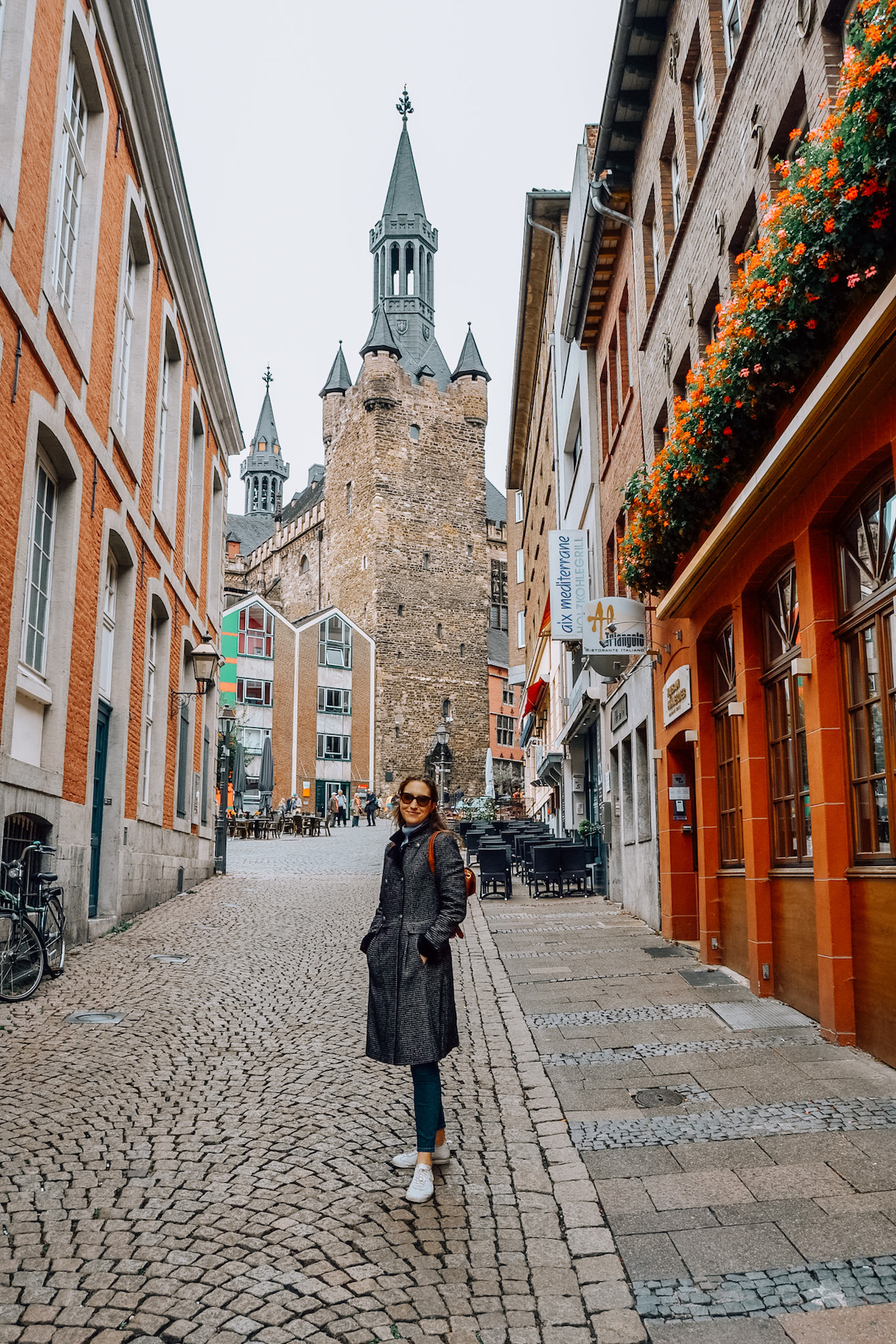
Is Aachen Worth Visiting? Final Thoughts
Heck yes! Whether you’re visiting Aachen, Germany as a day trip from Cologne, Bonn, or Maastricht or are staying in the city for a couple days, I have only good things to say about this historic city.
Drop me a comment below with any questions you have about Aachen, or let me know if you’ve been before!
Don’t forget to follow me on Instagram to keep up with my daily adventures in Berlin and beyond!

Comments & Reviews
Hello Claire!
I am getting ready to visit Aachen at the end of July. My grandfather was born there and I am just hoping to walk the streets where he grew up. Thank you for the information in your blog. honestly, yours is the first one of many blogs I have ever read completely!
Ruth Gleason Formerly Koch of Aachen, Germany
Hello Ruth, formerly of Aachen 🙂 I’m SO glad to hear you found my post on Aachen helpful and that you actually read the entire thing! I know I write long posts, but there’s always so much interesting information to share that I just can’t bear to cut things short. Enjoy your time in Aachen! It’s a wonderful city that I hope to revisit very soon myself.